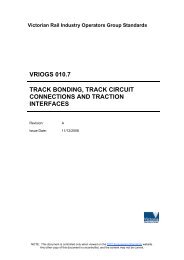VRIOGS 012.2.1 - Public Transport Victoria
VRIOGS 012.2.1 - Public Transport Victoria
VRIOGS 012.2.1 - Public Transport Victoria
Create successful ePaper yourself
Turn your PDF publications into a flip-book with our unique Google optimized e-Paper software.
42 <strong>VRIOGS</strong> <strong>012.2.1</strong> REVISION A<br />
shall be installed at points where there is a major change of direction greater than<br />
25 degrees, or where services leave the main cable route.<br />
c) The maximum length between adjacent pits shall be 300 metres and nominally 150<br />
metres.<br />
d) Where pits and cable turning chambers are installed on embankments, protection<br />
against erosion around and adjacent to the pit and special drainage arrangements<br />
shall be provided to ensure that there will be no undermining or deterioration of the<br />
embankment during periods of heavy rain.<br />
e) Where it is identified that a defined length of spare or slack cable is required for<br />
either;<br />
i. Future use<br />
ii.<br />
iii.<br />
iv.<br />
Additional Cable jointing purposes<br />
Temporary works<br />
Other identified purpose/s<br />
14.8 Location of Cable Jointing Pits<br />
a) Cable jointing pits shall be provided wherever:<br />
i. Fibre optic cable and communications cable is to be jointed and a suitable<br />
communications cable termination cabinet does not exist. All cables shall<br />
enter from the longer ends of fibre optic and communications cable pits and<br />
not from side entries.<br />
ii.<br />
Jointing of cabling near signals or signalling infrastructure is required<br />
b) Consideration shall be given to the need to have vehicular access for the jointing of<br />
cables and splicing of optical fibre cables, and as such cable jointing pits shall where<br />
possible be positioned where road access is available.<br />
14.9 Location of Cable Turning Chambers<br />
a) Cable turning chambers shall be installed in GLT, GST and cable ladder routes<br />
wherever cables are required to change direction sharply and either:<br />
i. The minimum bend radius for the cable cannot be achieved within the GLT,<br />
GST or cable ladder or,<br />
ii.<br />
The cable is likely to bear heavily against sharp edges at the bend.<br />
14.10Preferred Type Cable Pits<br />
a) Preferred type cable jointing pits and lids for rail signalling use are as within this<br />
Standard and refer to drawings 112000 / 5 /14, drawings 112000 / 5 /15, drawings<br />
112000 / 5 /16<br />
b) The Infrastructure Manager’s type approved list should also be consulted for all<br />
further types of approved pits and lids as acceptable for use.<br />
NOTE: This document is controlled only when viewed on the DOT Engineering Standards website.<br />
Any other copy of this document is uncontrolled, and the content may be inaccurate.

















